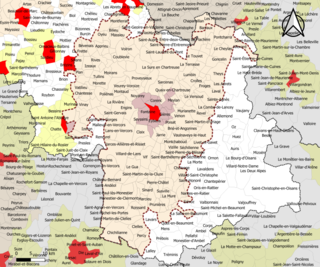
Geneva is the second-most populous city in Switzerland and the most populous city of Romandy, the French-speaking part of Switzerland. Situated in the south west of the country, where the Rhône exits Lake Geneva, it is the capital of the Republic and Canton of Geneva.

A metropolitan area or metro is a region that consists of a densely populated urban agglomeration and its surrounding territories sharing industries, commercial areas, transport network, infrastructures and housing. A metro area usually comprises multiple principal cities, jurisdictions and municipalities: neighborhoods, townships, boroughs, cities, towns, exurbs, suburbs, counties, districts, as well as even states and nations like the eurodistricts. As social, economic and political institutions have changed, metropolitan areas have become key economic and political regions.

An aire urbaine is an INSEE statistical concept describing a core of urban development and the extent of its commuter activity. It was replaced by the concept "functional area", which uses the same definition as Eurostat's functional urban areas, in 2020.

The city of Paris had a population of 2,165,423 people within its administrative city limits as of January 1, 2019. It is surrounded by the Paris unité urbaine, or urban area, the most populous urban area in the European Union. In 2018 the unité urbaine had a population of 10,816,803 in 2,854 km2 (1,102 sq mi). The Paris Region, or Île-de-France covers 12,012 km2 (4,638 sq mi), and has its own regional council and president. It has a population of 12,213,447 as of January 2018, or 18.3 percent of the population of France. The metropolitan or functional area of Paris covers 18,941 km2 (7,313 sq mi) and has 13,064,617 inhabitants (2018).
Aire-la-Ville is a municipality in the canton of Geneva in Switzerland.

In France, an urban unit is a statistical area defined by INSEE, the French national statistics office, for the measurement of contiguously built-up areas. According to the INSEE definition, an "unité urbaine" is a commune alone or a grouping of communes which: a) form a single unbroken spread of urban development, with no distance between habitations greater than 200 m and b) have all together a population greater than 2,000 inhabitants. Communes not belonging to an unité urbaine are considered rural.

The Paris metropolitan area is a statistical area that describes the reach of commuter movement to and from Paris, France and its surrounding suburbs.

Saint-Galmier is a city in eastern France. It is a commune in Loire department, and belongs to the arrondissement of Montbrison. Saint-Galmier covers an area of 19.5 square kilometers. As of January 1, 2018, it had a population of 5,737, ranking 1,903th among French communes.
The larger urban zone (LUZ), or functional urban area (FUA), is a measure of the population and expanse of metropolitan and surrounding areas which may or may not be exclusively urban. It consists of a city and its commuting zone outside it.

Nice metropolitan area as defined by INSEE in 2021 is the functional urban area or commuting zone of the city of Nice, southeastern France. It covers 100 communes, has 1,103,527 inhabitants (2021) and an area of 2,073 km2. It partly overlaps with the urban unit of Nice, which covers some cities, e.g. Antibes, Grasse and Cannes, that are part of the functional area Cannes-Antibes.

Saint-Martin-de-Bavel is a commune in the Ain department in eastern France.

Chambon is a commune in the Cher department in the Centre-Val de Loire region of France.

Marcilly-sur-Tille is a commune in the Côte-d'Or department in eastern France.
Talasani is a rural commune and village on the eastern seaboard of Corsica. It in the Haute-Corse department of France. The area has very low population density and is mainly forests and farmland. Being a coastal municipality, Talasani recognizes strict urban planning provisions in order to preserve the ecological balance of the coast.

Chanteau is a commune in the Loiret department in north-central France. It is part of the functional urban area of Orléans.
Champvoisy is a commune in the Marne department in north-eastern France. It is a rural municipality, with a very low population density. The municipality is part of the functional area of Reims, which is composed of 294 municipalities.
Pomps is a commune in the Pyrénées-Atlantiques département in south-western France. An individual from Pomps is known as Pompsois.

Grenoble metropolitan area as defined by INSEE in 2020 is the functional urban area of the city of Grenoble, southeastern France. It covers 204 communes, all in the Isère department. It has 714,799 inhabitants (2018) in an area of 2,876 km2 (1,110 sq mi), which is 39% of the Isère department. Grenoble and 15 other communes form the pôle urbain or urban cluster, the other 188 communes form the couronne or commuter belt. The most populous communes in the functional area are Grenoble, Échirolles, Fontaine, Meylan, Le Pont-de-Claix, Saint-Égrève, Saint-Martin-d'Hères, Sassenage, Seyssinet-Pariset and Voiron, all except Voiron part of the pôle urbain. It is the 11th-most populous functional urban area in France.

Cherbourg-en-Cotentin is a city in the department of Manche, Normandy, northwestern France, established on 1 January 2016. The commune takes its name from Cherbourg, the main town of the commune, and the Cotentin Peninsula. Cherbourg is an important commercial, ferry and military port on the English Channel. Cherbourg-en-Cotentin is a Maritime prefecture and sub-prefecture of Manche. Due to its union, it is the most populous commune in its department with 79,144 inhabitants as of 2018, making it the first city of the department before the Saint-Lô prefecture and the second in the region after Caen. Its urban unit is composed of three communes, and has 81,963 inhabitants (2018). Its larger functional area has 152,630 inhabitants (2018).














